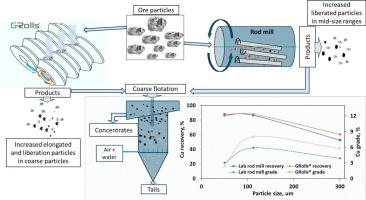粉碎机理对粗粒复合材料浮选的影响
IF 5
2区 工程技术
Q1 ENGINEERING, CHEMICAL
引用次数: 0
摘要
本研究考察了辊磨和棒磨的粉碎机制对颗粒特性和浮选性能的影响。特别侧重于粗颗粒浮选,旨在降低磨矿回路的能量。实验使用了HydroFloat™和使用斑岩铜金矿的机械搅拌池。grols®显示出优越的粗颗粒浮选,因为它沿着矿物边界优先破碎,产生更好的释放颗粒,铜暴露量更高。在HydroFloat™中,grols®产品在+ 150µm馏分中获得了3.6%的铜品位,而棒材磨产品的铜品位为2.8%。在机械搅拌槽中,grols®产品在+ 150µm馏分中也具有优异的性能,铜回收率为60%,品位为5.8%,而棒磨产品的回收率为52%,品位为3.9%。颗粒形态也影响浮选性能,较粗的颗粒中,细长的颗粒与较高的品位有关,而较细的颗粒中,圆形颗粒与增加的脉石夹带有关。两种粉碎方法下,HydroFloat™的流化床性能相似,这表明当粒度分布紧密匹配,在较低的表面水流速下使用相对较粗的颗粒时,颗粒形态对床动力学的影响最小。这些发现强调了粉碎策略和颗粒形状对优化浮选性能的重要性。本文章由计算机程序翻译,如有差异,请以英文原文为准。

Effect of comminution mechanism on flotation of coarse composites
This study investigates the impact of comminution mechanisms of GRolls® and rod mills on particle characteristics and flotation performance. Particular focus is given to coarse particles flotation, aiming at energy reduction in the grinding circuit. Experiments were carried out using both HydroFloat™ and mechanically agitated cells using porphyry copper–gold ore. GRolls® demonstrated superior coarse particle flotation due to preferential breakage along mineral boundaries, producing better-liberated particles with higher Cu exposure. In the HydroFloat™, GRolls® products achieved a Cu grade of 3.6 % in the + 150 µm fraction, compared to 2.8 % for rod mill products. In mechanically agitated cells, GRolls® products also delivered superior performance in the + 150 µm fraction, with a Cu recovery of 60 % and grade of 5.8 %, while rod mill products achieved 52 % recovery and 3.9 % grade.
Particle morphology also influenced the flotation performance, with elongated particles correlating with higher grades in coarser fractions and rounded particles linked to increased gangue entrainment in finer fractions. Fluidized bed properties in the HydroFloat™ were similar for both comminution methods, indicating that when particle size distributions are closely matched and relatively coarse particles are used at low superficial water velocities, particle morphology has minimal impact on bed dynamics. These findings highlight the importance of comminution strategies and particle shape in optimizing flotation performance for energy-efficient ore processing.
求助全文
通过发布文献求助,成功后即可免费获取论文全文。
去求助
来源期刊

Minerals Engineering
工程技术-工程:化工
CiteScore
8.70
自引率
18.80%
发文量
519
审稿时长
81 days
期刊介绍:
The purpose of the journal is to provide for the rapid publication of topical papers featuring the latest developments in the allied fields of mineral processing and extractive metallurgy. Its wide ranging coverage of research and practical (operating) topics includes physical separation methods, such as comminution, flotation concentration and dewatering, chemical methods such as bio-, hydro-, and electro-metallurgy, analytical techniques, process control, simulation and instrumentation, and mineralogical aspects of processing. Environmental issues, particularly those pertaining to sustainable development, will also be strongly covered.
 求助内容:
求助内容: 应助结果提醒方式:
应助结果提醒方式:


